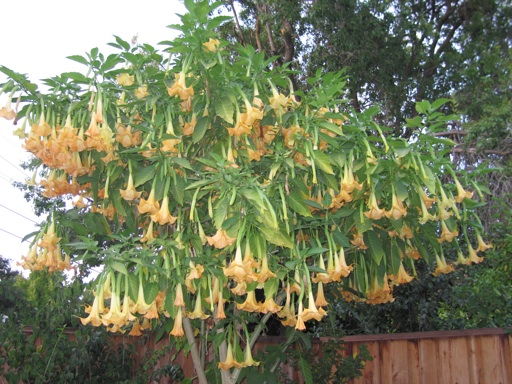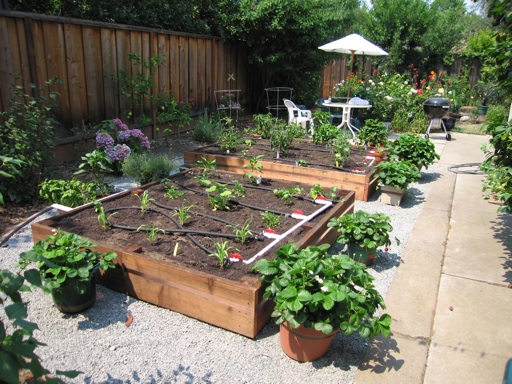Archive for July, 2008


These are pictures of a Charles Grimaldi brugmansia that I used to have growing in the yard. It reached its peak about two years ago. I watered it frequently in the beginning. It grew amazingly fast from about 3 feet tall to the size of a small tree (about 10 feet tall) in just 4 years. It was overloaded with large yellow trumpet-shaped flowers 3-4 times a year. The flowers were extremely fragrant. Their perfume-like fragrance could be smelled from inside the house on summer evenings when we had the windows open. It was the centerpiece of the yard.
One of main problems I had with brugmansias is keeping snails off of them. The snails love eating the leaves. Putting copper tape around the trunk helps keep them at bay. Another problem was the flowers tended to droop on warm summer afternoons when the plant was in full sun, even after a watering. The brugmansias that I planted in afternoon shade tended to hold their shape better. Also, Charles Grimaldi needs a lot of pruning to maintain an attractive shape, because it grows so fast.
During the freeze of January 2007, the temperature here dropped into the mid 20s, and my brugmansia froze to the ground. Only a few outshoots returned after that.
July 14 2008 | Brugmansia | Comments Off on Charles Grimaldi Brugmansia

One of the highlights of summer is the sight of jacaranda trees in bloom. Jacaranda trees are inconspicuous trees most of the year that seem to blend into the background. But every year in the month of June, the smattering of jacaranda trees in our neighborhood burst into bloom providing a breathtaking display of lavender flowers that cover the breadth of the canopy. The above picture was taken about 3 weeks ago in late June.
Jacaranda trees are probably my favorite flowering tree. They seem to grow amazingly well in the inland portions of the San Francisco Bay Area, despite the occasional freeze. Jacaranda trees suffer when the temperature drops below about 28°F. About 18 months ago, California suffered an unusually severe cold spell, with temperatures dropping into the mid to low 20s. Some Jacarandra trees in our neighborhood lost branches, but the trees survived and are now blooming again.
July 14 2008 | Jacaranda | Comments Off on Jacaranda Trees

Last week, I converted a lawn in my side yard into a vegetable garden. The garden includes two raised beds made of 12” x 2” untreated redwood. One bed is 6’ x 7’, and the second bed is 8’ x 6’. I decided not to make the beds wider than 6’ so that it would be easy to reach the plants without walking in the garden. The wood is secured into the ground with 4” stakes in each corner that are embedded in cement like fence posts.
Each garden bed is surrounded by 2’- 2.5’ wide gravel paths that have weed block underneath to make the plants more easily accessible.
Each bed has four soaker hoses that are set on a timer to water daily. Each of the eight soaker hoses has a red shut off valve. Each shut off valve can be turned on or off to supply water to the soaker hose. In the wintertime, I may decide to grow plants in only a portion of the garden. So I added the shut off valves to have the flexibility to water only the portion of the garden that has plants.
I haven’t had a vegetable garden since I was a child. Back then, my parents filled in an old sandbox with dirt, and we started growing vegetables. My sister and I had a lot of fun each summer taking care of the plants and watching them grow. We had fun watching the plants grow quickly and produce fruit within only a few months in the warm spring and summer weather.
Last week, my mom and I planted a variety of warm weather vegetables, fruits, and herbs. We planted a six pack of corn, 3 tomatoes, 5 peppers, 3 eggplant, 6 basil, 3 groups of cilantro, a six pack of onions, one set of zucchinis, and one set of cantaloupes. Because I am getting the garden started relatively late, I bought mostly larger seedlings to give them a head start. After planting, I gave them a thorough watering and shot of water soluble fertilizer.
The next day I put adhesive copper tape around the wooden perimeter of each of the raised beds. The copper tape helps to keep the snails and slugs out of the garden. They don’t seem to cross the copper tape. I have had a lot of luck using copper tape to keep snails out of my strawberry pots. It’s a great organic way to deal with snails without having to use pesticide near edible produce.
July 13 2008 | Fruit and Vegetables | Comments Off on New Vegetable Garden

Blenheim apricot tree with netting
I have fond memories of picking apricots from our Blenheim apricot tree in the summertime when I was growing up. We would eat them fresh, and my mom would cook apricot cobbler and apricot jam.
The fruit on the Blenheim apricot tree in my backyard is ripening this week, and they taste delicious. The fruit is very sweet with only a hint of tartness. Tree-ripened Blenheim apricots are the best tasting apricots. By tree-ripened, I mean apricots that are left on the tree until they are not only orange in color, but soft to touch. When the surface of the fruit is mostly hard when squeezed, it is not ready yet. Ideally, an apricot should be left on the tree until it is soft enough to make a small dent in the flesh. Usually, an apricot becomes soft enough to eat about week after beginning to turn orange.
Blenheim apricots often are not completely orange even when ripe. The side of the apricot that is exposed to the sun tends to turn orange, while the side of the apricot that is shaded from the sun may be a bit green or yellow, although the inside is soft and sweet. A Blenheim apricot will often have a characteristic greenish or yellowish cast on one side that distinguishes it from many of the commercially sold apricots that one finds in a grocery store.
I have heard that one of the reasons that fresh Blenheim apricots are rarely sold in grocery stores these days is because customers rarely select them due to their non-uniform color. Also, Blenheim apricots tend to rot a few days after they ripen. So, they do not have a long shelf life, and they are unsuitable for transport over long distances. That’s too bad, because Blenheim apricots are really the best tasting apricots in my opinion. It seems that the only way you can get them anymore is by growing a tree in your backyard.
Squirrels are the main problem I have had with growing apricots. Squirrels love apricots. They take them off the tree just as they are beginning to turn orange, before I consider them to be ripe. Squirrels in my area will strip all of the fruit off a tree in a matter of days. The only solution that works is to wrap the tree with bird netting. Every winter I trim the tree down to a height of about 10 feet tall. Fruit trees do not develop fruit on newly grown branches. Therefore, topping the tree to 10 feet ensures that the tree only develops fruit on the lower branches.
I only need to net the lower part of the tree, which requires a lot less effort than netting the full canopy. I use clothes pins to secure the net to the branches, and make sure that the net is wrapped around the inside branches as much as possible so that the squirrels can’t access the fruit by jumping past the net into the inner branches. Also I wrap part of the net around the trunk, and tie it with string so they can’t crawl up the trunk through a gap in the net. I have hardly lost any apricots to squirrels this way!
Blenheim apricots grow great in California. But because they bloom early (e.g., the first week of March in our area in 2008), they are hard to grow in regions that are prone to late frosts. A late frost could damage the blossoms or newly developing fruit.
July 13 2008 | Apricots | Comments Off on Blenheim Apricots Ripening
« Prev




